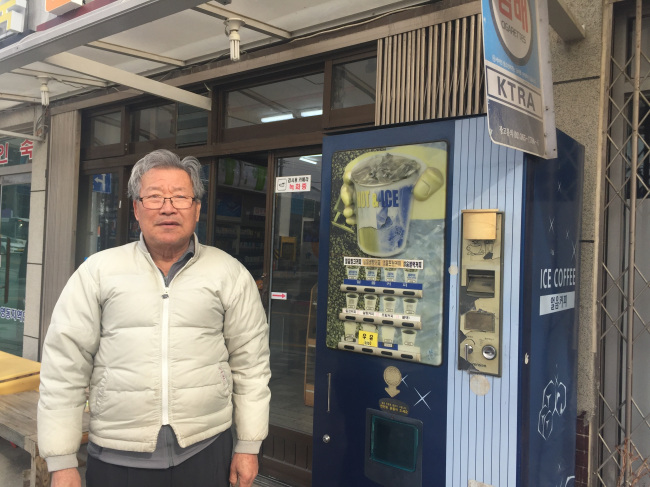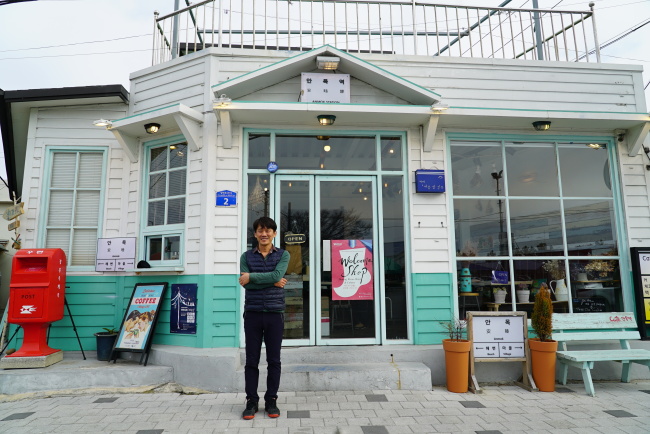[PyeongChang 2018] Gangneung’s disappearing treasure: coffee vending machines
Known for its coffee scene, the sub-host city of Winter Games offers remains of its early coffee culture
By Claire LeePublished : Feb. 9, 2018 - 16:35
GANGNEUNG, Gangwon Province -- A quiet costal town near PyeongChang, Gangnueng has long been known for its local coffee scene. The area is most famous for its annual coffee festival and “cafe street” -- where about 40 coffee shops can be spotted alongside Gangneung’s scenic Anmok beach.
During the upcoming Olympic Games, Gangenung is scheduled to host hordes of foreign visitors and athletes. The city will promote what it is known for, by holding a special edition of its annual coffee festival.
If one looks closely, however, the sub-host city of the Winter Olympics also offers interesting remains of an era that is now gone, including its old coffee vending machines which many view as the former version of today’s ongoing coffee boom and culture in the region.
During the upcoming Olympic Games, Gangenung is scheduled to host hordes of foreign visitors and athletes. The city will promote what it is known for, by holding a special edition of its annual coffee festival.
If one looks closely, however, the sub-host city of the Winter Olympics also offers interesting remains of an era that is now gone, including its old coffee vending machines which many view as the former version of today’s ongoing coffee boom and culture in the region.

Such machines, some as old as 30 years, can still be spotted throughout the city, including on Anmok beach. They still offer the kind of beverages they offered in the 1980s and the ‘90s. Options include black coffee (similar to Americano), milk coffee (similar to cafe latte) and sugar coffee (Americano with sugar added).
These machines only accept cash and a single drink is as cheap as 300 won ($0.27).
“No one makes much money out of these machines nowadays,” said Choi Kyeong-hwan, 81, who runs a convenience store near Gangneung KTX train station.
Outside his store, named “Samho Super,” stands an old-school coffee vending machine. It still works, in spite of it being 20 years old, although sometimes your coins falls right down to the return slot. You would get your beverage after making one or two unsuccessful attempts.
“But there was a time when one can make about 200,000 won a day by owning a single coffee vending machine on Anmok beach. I’m talking about 20 or 30 years ago.”
Indeed, the Anmok beach barely had any coffee shops 30 years before. Instead, it only had a few raw fish restaurants, residential buildings, and, most importantly, coffee vending machines.
Shot by Lim Jeong-yeo / Edited by Lim Jeong-yeo
This was an era when people didn’t really know what an Americano was, but used a term called a “two, two, two” -- meaning a beverage that consists of two spoons of sugar, two spoons of cream and two spoons of instant coffee.
Those who remember say the machines were something that was revolutionary -- it allowed people to enjoy their “two, two, two”s without having to make the beverage themselves, when cafes were rare and buses did not run often to and from the city center.
Unsurprisingly, those who have lived in Gangneung for a long time associate coffee and this particular beach with memories of their youth.
For them, their younger days were filled with images of Anmok’s clear waters, the green of its pine trees and the dramatic moonrises -- all of which also remind them of the sugar coffee or black coffee by the beach’s vending machines.
Kim Woo-yeong runs a cafe named Anmokyeok (meaning Anmok Station) near the Anmok beach, where he spent a lot of time during his university years. He recently returned to this beach after working for many years in Jeongseon, Gangwon Province.
“Coffee was such a cool thing when I was in college,” he said.
“It symbolized those who are intelligent and the high society. And Anmok was such a gem as a beach, although getting there wasn’t too easy as there were only about three buses running daily at the time. After enjoying the sunset at Gangneung’s Gyeongpo Lake, we would walk for hours and hours just to see the moonrise there, and have a cup of coffee using one of those vending machines.
This was an era when people didn’t really know what an Americano was, but used a term called a “two, two, two” -- meaning a beverage that consists of two spoons of sugar, two spoons of cream and two spoons of instant coffee.
Those who remember say the machines were something that was revolutionary -- it allowed people to enjoy their “two, two, two”s without having to make the beverage themselves, when cafes were rare and buses did not run often to and from the city center.
Unsurprisingly, those who have lived in Gangneung for a long time associate coffee and this particular beach with memories of their youth.
For them, their younger days were filled with images of Anmok’s clear waters, the green of its pine trees and the dramatic moonrises -- all of which also remind them of the sugar coffee or black coffee by the beach’s vending machines.
Kim Woo-yeong runs a cafe named Anmokyeok (meaning Anmok Station) near the Anmok beach, where he spent a lot of time during his university years. He recently returned to this beach after working for many years in Jeongseon, Gangwon Province.
“Coffee was such a cool thing when I was in college,” he said.
“It symbolized those who are intelligent and the high society. And Anmok was such a gem as a beach, although getting there wasn’t too easy as there were only about three buses running daily at the time. After enjoying the sunset at Gangneung’s Gyeongpo Lake, we would walk for hours and hours just to see the moonrise there, and have a cup of coffee using one of those vending machines.

“We would call these machines as cafes and give each a different name. One was called the ‘Anmok cafe’ and the other was called the ‘Moon Cafe,” because we enjoyed the moonlight at Anmok so much.”
People in Gangneung have different stories when asked why and how Anmok became the spot for such vending machines.
Yi Jong-deok, who is the director of Gangneung Culture and Arts Foundation, says Gangneung has always been popular among anglers, as the city’s got many spots where the water coming in from the ocean meets the rivers. The Anmok beach, which is near the Gangneung port, was no exception.
“I think the first coffee vending machine was set up by someone who was smart enough to come up with this idea to attract anglers who would spend many hours at the beach, even at nights,” Yi told The Korea Herald.
“And I guess it all went from there -- more machines appeared as anglers wanted coffee and Anmok beach would always have anglers throughout the year.”

Kim Woo-yeong has a rather different story.
He says Anmok had been known as the place to “meet pretty girls” among his male colleagues and friends at college.
“Today’s Gangneung Yeongdong University used to be a nursing school when I was in college,” he said.
“And apparently if you take a bus from the stop that’s nearest to the nursing school’s campus, the bus will drop you off at the Anmok beach as it was the route’s final destination. So the nursing students -- they were known as the prettiest girls in town at the time -- would go to the beach very often, and male students from other universities would visit the beach in the hope of asking them out or maybe even have coffee together."
Yi says there is some truth in Kim’s story. “At the time, to ask someone to go to Anmok meant that you were willing to spend at least half a day with him or her,” he said.
“There were not that many buses at the time, and even to walk back to the center of Gangneung, it would take a few hours. You would have a cup of coffee while looking at the blue waters, and walk back to the city through the pine forest. I would say it was a pretty romantic way of spending a day in Gangneung.”
Even if the machines offered the same kind of beverages -- the milk coffee, the cream coffee and the sugar coffee -- each machine’s drink would taste different from one another.
“I guess that’s what I liked about being at the beach,” said Kwon Oh-su, a cab driver who has been living in Gangneung for 27 years.
“You would choose this machine when you visit the beach in the morning, and the other machine when you go there at night. Today’s cafes are also nice, but there was something special about driving all the way to Anmok just to have your morning coffee there, get the beverage out of these machines, and drinking it inside your vehicle while watching the morning waves.”
Gangneung is also known as a place where some of the nation’s most prominent writers and artists were born and raised.
Among the famous are poet Heo Nanseolheon (1563-1589), Confucian scholar Yi I (1536-1584), writer Yun Hu-myong (born in 1946) and author So Young-en (born in 1943) just to name a few.
Yi Jong-deok from the Gangneung Culture and Arts Foundation says the work by such artists and Gangneung’s nature are inseparable from one another.
Nestled at the east side of Korea’s longest mountain range, it has mountains that are marked by steep slopes, clear oceans and tranquil lakes, many of which have been captured and featured by the artists born and raised in the city.
“And artists and coffee or tea are inseparable from each other as well,” Yi said. “In order to understand Gangneung and its coffee culture, you have to understand the connection between its nature, its artists in history and coffee. Today’s coffee boom in Gangneung did not happen overnight.
The machines are now gone and have been replaced by cafes, but some things are still the same.”
Kim Woo-yeong says foreign visitors could also enjoy the part of Gangneung that he’s been appreciating throughout his life.
“There really is no place like Anmok -- I’m so proud of this place,” he said. “I hope they can walk through the beach with a cup of coffee in their hands, appreciating the waters; I hope they can listen to the sounds of the wind blowing through the pine trees while sipping their coffee. For me, this is Gangneung.
“A cup of coffee often makes people stay, wherever they are at that moment, a little longer. I hope a cup of coffee can do that for those who’ll visit Anmok during this Olympic season.“
There are currently three coffee vending machines right beside the local chain coffee-shop Twosome Place at Anmok beach. The address is 287-43 Gyeonso-dong, Gangneung-si, South Korea.
For more information on Gangneung's “cafe street,” call +82 33 640 4531.
By Claire Lee (dyc@heraldcorp.com)


![[Exclusive] Korean military set to ban iPhones over 'security' concerns](http://res.heraldm.com/phpwas/restmb_idxmake.php?idx=644&simg=/content/image/2024/04/23/20240423050599_0.jpg&u=20240423183955)

![[Graphic News] 77% of young Koreans still financially dependent](http://res.heraldm.com/phpwas/restmb_idxmake.php?idx=644&simg=/content/image/2024/04/22/20240422050762_0.gif&u=)



![[Pressure points] Leggings in public: Fashion statement or social faux pas?](http://res.heraldm.com/phpwas/restmb_idxmake.php?idx=644&simg=/content/image/2024/04/23/20240423050669_0.jpg&u=)









